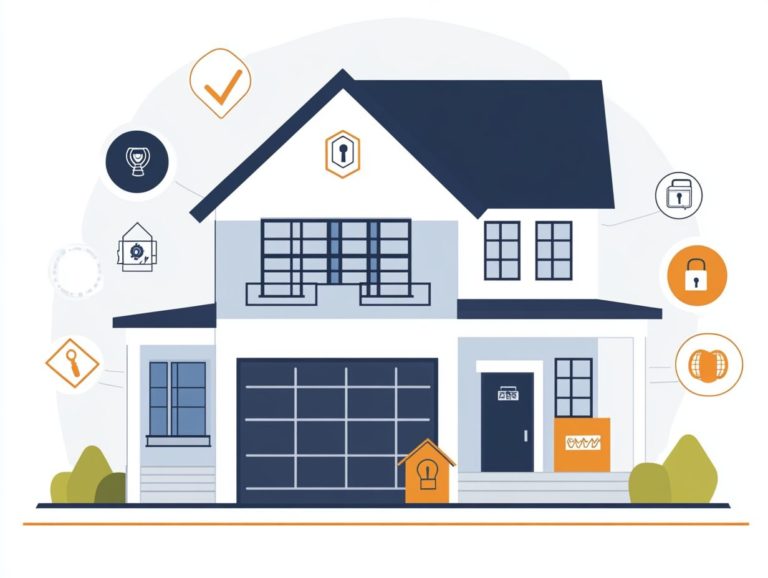Understanding the Perils in Home Insurance Types
Home insurance is more than just a safety net; it s an essential investment in the protection of your property and belongings.
With a variety of policies available, each designed to meet different needs, it s crucial for you to understand the coverage you’re securing.
This article delves into the types of home insurance, the common risks they cover, and the exclusions you should keep in mind.
You ll find guidance here to help you navigate your policy and tips for selecting the right coverage tailored to your unique circumstances.
Join us as we break down the essentials of home insurance, ensuring you re well-equipped for whatever life may throw your way.
Contents
Key Takeaways:

Ensure you understand the types of home insurance coverage available and choose the one that meets your specific needs.
Be aware of the risks covered by home insurance and the common causes of damage and loss that may not be included in your policy.
Read and interpret your policy thoroughly to understand the coverage and any exclusions or limitations.
Consider all factors before selecting a home insurance policy.
Types of Home Insurance
Understanding the different types of home insurance is essential for homeowners seeking to safeguard their property from potential financial setbacks, including knowing the role of home insurance providers.
Homeowners insurance typically offers a variety of policy options, including named risks and open risks coverage. Each option addresses specific risks related to property damage.
By recognizing the strengths and limitations of these policies, you can make informed decisions about your coverage levels. This ensures that you are well-protected against common threats such as fire, theft, and vandalism, as well as less frequent but catastrophic events like earthquakes and floods.
Overview of Different Policies
Homeowners insurance falls into two primary categories: named risks and open risks policies. Each offers a unique approach to covering property damage.
With named risks policies, you ll find a clear list of the risks covered think fire, theft, and certain natural disasters. You ll only receive compensation for damages stemming from these explicitly listed events. While this focused approach might lead to lower premiums, it does come with the trade-off of limited coverage to just those specified risks.
On the other hand, open risks policies offer a more comprehensive safety net; they cover all risks unless clearly excluded. This can change how you address unexpected damages that might not make the list.
When deciding between these options, it s vital to consider your unique risk profile alongside the terms offered by your insurance company. This will help you determine which policy aligns best with your specific needs.
Risks Covered by Home Insurance
Homeowners insurance is crafted to safeguard against a range of risks that can inflict considerable damage on your property. This coverage allows you to recover from unforeseen financial setbacks.
The most commonly covered risks such as fire, theft, vandalism, and water damage can lead to expensive repairs and disrupt your daily life.
Grasping what qualifies as a covered risk within your insurance policy is vital for managing your risks effectively. This knowledge ensures that you are well-protected and prepared when it comes time to file a claim for damages.
Common Causes of Damage and Loss

Common causes of damage and loss covered by homeowners insurance typically include events such as fire, theft, vandalism, and various forms of water damage. Each presents unique risks that you, as a homeowner, must be aware of.
These risks can impose not only significant financial strain but also emotional distress. For instance, imagine coming home to find your basement flooded after a storm. A house fire can lead to the devastating loss of cherished possessions and the home itself.
In the aftermath of such events, it s crucial for you to understand the claims process. This often involves meticulously documenting the damage and submitting evidence for evaluation.
Equally important is your understanding of policy exclusions. Not all incidents are covered, so knowing what is excluded can save you from unwelcome surprises when filing claims.
Don’t wait until it’s too late! Review your current home insurance policy or consult an insurance expert today to ensure you have the protection you need.
Perils Not Covered by Home Insurance
While homeowners insurance provides extensive coverage, it’s essential to recognize the perils your policy may not include. Knowing what to look for in home insurance coverage can help prevent exclusions that may leave you exposed to significant financial losses.
Risks like floods, earthquakes, and certain water damage are frequently left out of standard policies. You may need additional coverage or endorsements to safeguard against these potential liabilities.
By understanding these exclusions and the associated deductibles, you can effectively manage your risk and ensure comprehensive protection for your valuable assets.
Exclusions and Limitations
Homeowners insurance policies come with specific exclusions and limitations that can significantly impact your coverage.
For example, many policies typically exclude damages caused by natural disasters like floods and earthquakes, potentially leading to substantial financial burdens in the aftermath. These exclusions can vary widely among different insurance companies. Some may offer optional riders for additional coverage, while others strictly limit compensation in such scenarios.
It’s crucial for homeowners to assess these limitations carefully. Overlooking them could leave you vulnerable to devastating financial losses when catastrophic events strike.
Understanding these nuances not only gives you the power to make informed decisions but also underscores the importance of having tailored coverage that aligns with your unique risks and location.
Understanding Your Coverage
Understanding your homeowners insurance coverage is crucial for ensuring you are fully protected against various risks and potential financial setbacks. This involves knowing what your policy covers and being aware of the deductible amount and its impact on your risk management strategy.
By familiarizing yourself with your policy s specifics, you can make informed decisions that align with your needs, granting you peace of mind in the face of unexpected damages or claims.
Reading and Interpreting Your Policy

Reading and interpreting your homeowners insurance policy is a vital step in grasping the full extent of your coverage and the risks you may face. This process demands careful attention to detail, as various sections can profoundly influence your financial protection in the event of loss or damage.
It s essential to delve into the coverage specifics, where you’ll uncover the types of perils included and the protection limits set forth. Pay particular attention to the exclusions these outline what isn t covered and can help you avoid unexpected financial strains.
Understanding the deductible amounts what you’ll need to pay out-of-pocket before the insurance steps in can aid in your budget planning and enhance your overall financial literacy regarding home protection.
Choosing the Right Home Insurance
Selecting the right homeowners insurance demands thoughtful consideration of several key factors that can influence your coverage and financial security.
As you choose a policy, it s crucial to assess the specific risks unique to your home, the types of perils covered, and the reputation of the insurance provider.
By carefully comparing various policies and reflecting on your individual needs, you empower yourself to make a well-informed decision one that ensures you have adequate protection against potential losses.
Factors to Consider when Selecting a Policy
When selecting a homeowners insurance policy, you need to consider several key factors to ensure that you are adequately protected against potential risks and financial liabilities.
Understanding coverage limits is essential; these limits determine the maximum amount your policy will pay in the event of a claim. Evaluating deductibles is also crucial, as it allows you to strike a balance between premium costs and out-of-pocket expenses in case of damage.
It’s equally important to assess the extent of peril coverage, which specifies what types of disasters are included in your policy. Research the insurance company’s reputation and customer service ratings for insight into how they handle claims and support their clients when needed.
By considering these elements, you can make a more informed decision and gain peace of mind regarding your coverage.
Frequently Asked Questions
Are you fully protected against all potential risks? Here are some common questions about homeowners insurance:
- What types of perils are typically covered? Most policies cover fire, theft, and certain types of water damage, but not floods or earthquakes.
- What is a deductible? A deductible is the amount you pay out-of-pocket before your insurance covers the rest.
- How can I add additional coverage? You can ask your insurance provider about optional riders for extra protection.
Don’t leave your home unprotected; understand your insurance policy now! Ready to secure your home? Get a quote today!
What are the different types of risks covered by home insurance?

Home insurance generally covers two types of risks: named risks and all-risk. Named risks include specific items listed in your policy, while all-risk covers a broader range unless explicitly excluded.
Why is it important to understand these risks?
Understanding your home insurance risks is vital. It helps you know how well protected you are and if you need extra coverage for any gaps. For more insights, explore what every homeowner should know about insurance.
What are common risks covered?
- Fire
- Theft
- Vandalism
- Natural disasters like hurricanes, tornadoes, and earthquakes
- Water damage, mold, and personal liability (in some cases)
Are all risks covered by home insurance?
No, not all risks are included. Review your policy to see what’s covered and what’s not, as certain things like flood damage and intentional damage may be excluded.
Can I customize my home insurance?
Yes, you can customize your home insurance. You can add extra coverage options for specific risks that aren’t included in your standard policy.
How can I ensure I have adequate coverage?
To make sure you have enough coverage, review your policy carefully. Consult with an insurance agent to add necessary coverage options based on your needs.
Take control of your home insurance today! Review your policy now to ensure you’re fully protected.






